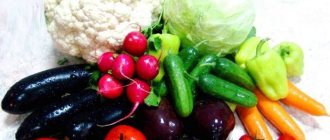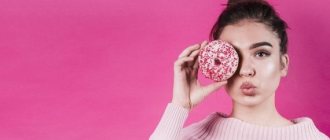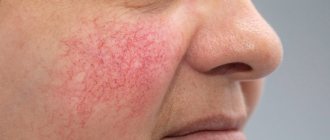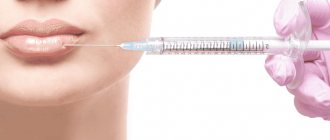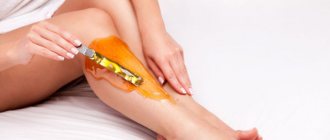Published: 01/18/2018 Updated: 03/09/2021
Of course, if there is a food allergy confirmed by clinical diagnostic studies, the doctor prescribes a specialized diet. But there is also a non-specific hypoallergenic diet approved by Russian doctors. It can be followed regardless of the nature of the allergen (household, insect, medicinal) to reduce the burden on the body and speed up recovery. Including atopic dermatitis, which often worsens in winter.
General rules
Food allergies ( urticaria , angioedema and others) are based on individual immunoconflict reactions to certain protein antigens contained in food products, which are absolutely harmless to most other people.
Urticaria is a group of diseases of various etiologies and is manifested by skin elements in the form of an urtic rash (blisters) localized both on the surface of the skin and on the mucous membranes, gradually enlarging and merging with each other and accompanied by itching. The most common is allergic urticaria, which is caused by various types of allergens, including food products. In principle, almost all food products are allergenic to one degree or another.
Below is a list of the most common food allergens:
- products containing animal proteins: milk, eggs, seafood;
- cereals: wheat, rice, rye, barley, corn, oats, cane;
- cruciferous vegetables: cabbage (white cabbage, Brussels sprouts, cauliflower), mustard, turnip, horseradish, radish;
- pumpkin: cucumber, pumpkin, watermelon, melon, zucchini;
- citrus fruits (tangerines, oranges, lemons);
- Compositae: artichoke, chicory, lettuce, sunflower;
- legumes: lentils, beans, soybeans, peas;
- buckwheat: buckwheat, rhubarb;
- nightshades: tomatoes, potatoes, red and green peppers, eggplants;
- heathers: cranberries, blueberries, lingonberries;
- Rosaceae: strawberry, wild strawberry, plum, pear, apple, peach, apricot, almond;
- umbelliferous: dill, parsley, celery, onion;
- Liliaceae: onion, asparagus, garlic;
- histamine liberators (products that do not cause allergies in themselves, but provoke the release of the allergy mediator - histamine : food additives in the form of flavors, dyes, preservatives, chocolate, coffee, vinegar, smoked meats, mustard, mayonnaise, alcohol).
A diet for urticaria in adults is an essential component of treatment and is aimed at excluding (eliminating) foods (if known) that provoke allergic reactions from the patient’s diet. If such a food agent is not identified, then an elimination diet can also be used for diagnostic purposes. In general, a diet for food allergies should be based on the following principles:
- exclude from your diet food agents known to you that provoke allergic reactions and foods that cause a cross-reaction in you (for example, all red vegetables, berries and fruits);
- Avoid excess protein content in the diet;
- do not include unknown or genetically modified products on the menu;
- eat simple food containing a minimum of ingredients, exclude complex dishes, including various seasonings and sauces;
- use only fresh products, avoid shelf-stable products (canned food, preserves);
- give preference to homemade dishes, do not include semi-finished products in your diet;
- try to optimally diversify the menu, since a product that is often eaten can have a sensitizing effect;
- limit the consumption of table salt and simple carbohydrates, as well as fried, spicy and salty foods;
- Completely avoid drinking alcoholic beverages.
Despite the fairly large list of foods to be excluded or limited, a hypoallergenic diet should be physiologically complete, but not excessive in energy value and micronutrient (especially proteins). Allergenic foods and dishes containing them even in minimal quantities are excluded from the diet. So, if you are allergic to chicken eggs, avoid creams, mayonnaise, baked goods, casseroles and all dishes that contain eggs in the recipe.
If the allergic trigger is not known, then the diet is limited to foods that most often cause an allergic reaction - eggs, milk, fish, seafood, citrus fruits, fish caviar, tomatoes, chocolate, honey, strawberries, melon, nuts. At the same time, it must be taken into account that prolonged heat treatment of products reduces their allergic properties. In chicken eggs, proteins are of great allergic significance.
Easily digestible carbohydrates (sugar and products containing it - sweets, jam, confectionery), chocolate, honey are subject to restrictions, thereby reducing the inflammatory process. Sugar can be replaced with saccharin , xylitol , and sweetener . The diet increases the content of vitamins and bioflavonoids , which strengthen the walls of blood vessels. The consumption of salt and salty foods is significantly limited.
The diet is enriched with foods rich in calcium (fermented milk drinks, cottage cheese), which has anti-allergic and anti-inflammatory effects. At the same time, limit the diet to foods containing a high amount of oxalic acid, which reduces the absorption of calcium.
Some types of fish are subject to exclusion (herring, mackerel, tuna, and “red” fish, the meat of which contains a large amount of histamine, which increases allergic reactions). Almost all crustaceans (crabs, shrimp, crayfish, lobsters) have pronounced cross-antigenicity, therefore, in case of intolerance to one species, it is necessary to exclude other species from the diet.
Spices and seasonings, strong meat, mushroom and fish broths, spicy dishes, smoked foods and sauces are excluded or limited. Milk globulins have pronounced allergic properties, which should also be excluded. It is preferable to prepare dishes by boiling or baking; frying foods is prohibited. Chemical sparing of the gastrointestinal tract reduces the absorption of allergenic triggers in the intestines. To improve the digestion of potential allergens - food proteins, it is necessary to practice fractional meals and a reduced portion size.
Urticaria in adults can occur in both acute and chronic forms with periodic exacerbations and remissions, and each of these forms has the specifics of therapeutic nutrition. During an exacerbation, a hypoallergenic diet that is extremely limited in the range of products (to which there is no allergic reaction) is prescribed.
As the clinical manifestations subside, various vegetables and fruits are introduced into the diet in small doses: first, green or yellow in color, and after a few days, in the absence of rashes, representatives of these families of orange (pumpkin) and red color. In small quantities, boiled fish of low-fat white varieties, white bread, fresh onions, fruit puree and freshly squeezed juices, compotes are introduced into the diet.
List of prohibited products
You should avoid the following products:
- citrus
- walnuts and hazelnuts
- bee honey
- cocoa beans
- black coffee
- chocolates
- sodas, especially sweet ones, and with dyes
- mushrooms
- berries: raspberries, strawberries, blueberries, blueberries
- fruits: peach, plum, pomegranate
- eggs
- semi-finished products
- products in marinade
- smoked meats: sausages, sausages, canned food
- baking
- mayonnaise sauces
- pork meat
- fish and meat broths
- spicy varieties of cheeses.
Minimize:
- tomatoes, beets, carrots, sweet peppers
- fish caviar and sea fish
- any milk products
- Minimum use of spices, especially salt
- eat one or two slices of bread
This is an approximate list, something can be added or excluded, the doctor should determine the diet based on the root cause of the rash.
Varieties
Elimination diagnostic diet
As stated, the optimal treatment option for hives when a causative food agent is identified is to remove or avoid it. However, if such an agent is not identified, elimination diets are used for diagnostic purposes, the procedure for which is given below. It is carried out in a hospital setting.
The patient is prescribed complete fasting for 3-5 days with a free fluid intake of 1.5 liters per day. Before fasting, the patient takes a saline laxative ( magnesium sulfate ) once. Every day during fasting, cleansing enemas are performed, light physical activity and two showers are required. As a rule, during fasting, the symptoms of urticaria , and new rashes do not appear.
One type of product is introduced into the patient’s diet, which is taken on an empty stomach in the morning in the amount of 100 g and then, 4 times a day, 200 g for 2 days. Every 2 days a new product is added to the previously introduced one. At the same time, every morning a provocative test is carried out with the intake of the connected product. It is recommended to start forming a diet with vegetables, for example, boiled potatoes, after 2 days carrots are introduced, then bread products, dairy products, beef, chicken, fish, eggs and so on.
Lastly, those foods that, in the patient’s opinion, cause an exacerbation are introduced into the diet. The appearance of fresh rashes after taking any of the studied products confirms its significance in the occurrence of an allergic reaction. On this day (if a reaction occurs), fasting for 24 hours and cleansing enemas without taking medications are again prescribed. After the disappearance of allergic rashes the next morning, a new, untested product is introduced and a provocative test is performed. Over the next two days, already researched and well-tolerated food products with newly connected ones are introduced into the menu.
Thus, thanks to the elimination diagnostic diet, it becomes possible to create a basic diet (basic foods) for each specific patient. If it is necessary to further expand the diet, new products are introduced no earlier than once every 3 days. It is recommended to keep a special “food diary”, which reflects the patient’s body’s reaction to all newly introduced foods. At the same time, you need to be extremely careful with identified allergenic products, eliminating them from the diet not only in their pure form, but also monitoring their presence in other dishes, as well as products that have cross-properties with the allergen.
Diagnosis of urticaria
The doctor can make a preliminary diagnosis immediately after examining the patient’s skin. The spots that appear on the body due to urticaria are difficult to confuse with another skin pathology. But in order to eliminate error, establish the cause of the disease and prescribe the most effective treatment, the patient is additionally prescribed tests:
- General blood analysis. This is done in order to understand whether there is anemia, whether the erythrocyte sedimentation rate (ESR) is increased and, thus, exclude/confirm the presence of immune or inflammatory processes.
- Stool analysis. Indicated for the detection of parasites as a cause of allergic urticaria.
- Functional liver tests. They determine the functioning of the organ and exclude its diseases.
Also during diagnosis, a study of thyroid function is usually carried out to find out whether the disease is caused by hyper- or hypothyroidism.
To identify the allergen that is responsible for hives, the patient is recommended to do skin allergy tests or donate blood from a vein.
Authorized Products
The diet of a hypoallergenic diet should include lean (without skin) dietary meat of chicken, turkey, rabbit, boiled or stewed. Potatoes boiled as a puree in water or in separate pieces are allowed as a side dish. From cereals - buckwheat, wheat, oatmeal.
The first courses are prepared in vegetable broth without frying with the addition of garden herbs. It is allowed to include low-fat fermented milk products, fresh low-fat cottage cheese and yogurt without additives in the diet.
For baked goods, you can eat whole grain or bran bread, dry biscuits, pasta, and durum wheat.
Vegetables: stewed or boiled zucchini, cabbage, cucumber, onion, lettuce. Among fats, preference is given to vegetable fats (sunflower or olive).
Table of permitted products
| Proteins, g | Fats, g | Carbohydrates, g | Calories, kcal | |
Vegetables and greens | ||||
| eggplant | 1,2 | 0,1 | 4,5 | 24 |
| beans | 6,0 | 0,1 | 8,5 | 57 |
| zucchini | 0,6 | 0,3 | 4,6 | 24 |
| cabbage | 1,8 | 0,1 | 4,7 | 27 |
| broccoli | 3,0 | 0,4 | 5,2 | 28 |
| Brussels sprouts | 4,8 | 0,0 | 8,0 | 43 |
| cauliflower | 2,5 | 0,3 | 5,4 | 30 |
| green onion | 1,3 | 0,0 | 4,6 | 19 |
| bulb onions | 1,4 | 0,0 | 10,4 | 41 |
| cucumbers | 0,8 | 0,1 | 2,8 | 15 |
| squash | 0,6 | 0,1 | 4,3 | 19 |
| parsley | 3,7 | 0,4 | 7,6 | 47 |
| salad | 1,2 | 0,3 | 1,3 | 12 |
| beet | 1,5 | 0,1 | 8,8 | 40 |
| celery | 0,9 | 0,1 | 2,1 | 12 |
| asparagus | 1,9 | 0,1 | 3,1 | 20 |
| Jerusalem artichoke | 2,1 | 0,1 | 12,8 | 61 |
| pumpkin | 1,3 | 0,3 | 7,7 | 28 |
| dill | 2,5 | 0,5 | 6,3 | 38 |
| beans | 7,8 | 0,5 | 21,5 | 123 |
| garlic | 6,5 | 0,5 | 29,9 | 143 |
| lentils | 24,0 | 1,5 | 42,7 | 284 |
Fruits | ||||
| avocado | 2,0 | 20,0 | 7,4 | 208 |
| pears | 0,4 | 0,3 | 10,9 | 42 |
| nectarine | 0,9 | 0,2 | 11,8 | 48 |
| peaches | 0,9 | 0,1 | 11,3 | 46 |
| apples | 0,4 | 0,4 | 9,8 | 47 |
Berries | ||||
| gooseberry | 0,7 | 0,2 | 12,0 | 43 |
| black currant | 1,0 | 0,4 | 7,3 | 44 |
Nuts and dried fruits | ||||
| nuts | 15,0 | 40,0 | 20,0 | 500 |
| flax seeds | 18,3 | 42,2 | 28,9 | 534 |
| sunflower seeds | 20,7 | 52,9 | 3,4 | 578 |
Cereals and porridges | ||||
| buckwheat (kernel) | 12,6 | 3,3 | 62,1 | 313 |
| semolina | 10,3 | 1,0 | 73,3 | 328 |
| oat groats | 12,3 | 6,1 | 59,5 | 342 |
| cereals | 11,9 | 7,2 | 69,3 | 366 |
| wheat bran | 15,1 | 3,8 | 53,6 | 296 |
Flour and pasta | ||||
| pasta | 10,4 | 1,1 | 69,7 | 337 |
Dairy | ||||
| kefir 0% | 3,0 | 0,1 | 3,8 | 30 |
| kefir 1% | 2,8 | 1,0 | 4,0 | 40 |
Cheeses and cottage cheese | ||||
| cottage cheese 0.6% (low fat) | 18,0 | 0,6 | 1,8 | 88 |
| curd tofu | 8,1 | 4,2 | 0,6 | 73 |
Meat products | ||||
| beef | 18,9 | 19,4 | 0,0 | 187 |
Bird | ||||
| chicken fillet | 23,1 | 1,2 | 0,0 | 110 |
| turkey | 19,2 | 0,7 | 0,0 | 84 |
Fish and seafood | ||||
| seaweed | 0,8 | 5,1 | 0,0 | 49 |
Oils and fats | ||||
| butter | 0,5 | 82,5 | 0,8 | 748 |
| linseed oil | 0,0 | 99,8 | 0,0 | 898 |
| olive oil | 0,0 | 99,8 | 0,0 | 898 |
| sunflower oil | 0,0 | 99,9 | 0,0 | 899 |
Non-alcoholic drinks | ||||
| mineral water | 0,0 | 0,0 | 0,0 | — |
| instant chicory | 0,1 | 0,0 | 2,8 | 11 |
| green tea | 0,0 | 0,0 | 0,0 | — |
Juices and compotes | ||||
| rose hip juice | 0,1 | 0,0 | 17,6 | 70 |
| * data is per 100 g of product | ||||
List of safe products
Despite the impressive list of prohibited foods, there are many safe foods that doctors often approve. Nutrition will be complete if you combine foods rich in proteins, carbohydrates, fats, and vitamins. The main thing is not to lose weight, but to eat well and get well. The diet includes the following products:
- rabbit, turkey meat, chicken, veal
- grain crops: millet, buckwheat, rolled oats, barley and rice
- cabbage, zucchini, potatoes, onions, cucumbers
- dill, lettuce, spinach, parsley
- pears, apples, cherries
- vermicelli
- bran bread
- sunflower and olive oil
- fructose
- cookies without margarine
- kefir with a minimum percentage of fat, yogurt without preservatives, curdled milk, cottage cheese and acidophilus
- of teas - only the green variety, it can be drunk weak
Hives are an unpleasant red rash that appears on the skin in different places. Usually it is not an independent disease, it is a symptom. It can appear, for example, as a reaction to stress or hormonal imbalance.
Often accompanies bronchial asthma. Sometimes hives occur due to an allergic reaction to a certain product, and then go away.
Fully or partially limited products
The diet for acute/chronic urticaria involves the complete exclusion of such products as fatty red meats, strong meat and fish broths, as well as first courses based on them, duck, goose, smoked meats, most sausages, whole milk, chicken eggs, fish, especially , “red” fish of all kinds.
Citrus fruits, chocolate, seafood (shrimp, mussels, squid), flour products and sweets, honey and honey products (propolis, bee jelly, wax), any salty foods, canned food, pickled vegetables, animal and cooking fats, salty and fatty are prohibited. cheeses, cream, sweet curds, sour cream.
All products containing easily digestible carbohydrates are excluded - sugar and products containing it, honey, jams, preserves, sweets, confectionery, ice cream. Semolina, rice and pasta, and soy are subject to restrictions.
Red and orange fruits/vegetables (tangerines, red apples, oranges, tomatoes, radishes, beets, radishes, carrots, strawberries, strawberries), nuts (especially peanuts and hazelnuts) are excluded from the diet; coffee; vinegar, all seasonings (mustard, ketchup, horseradish, mayonnaise), mushrooms, eggplant, pineapple, melon, butter dough.
The hypoallergenic menu should not include products containing food additives (dyes, preservatives), fruit tea, fruit/vegetable juices from prohibited berries, vegetables and fruits, sweet carbonated drinks and any alcohol-containing drinks.
Table of prohibited products
| Proteins, g | Fats, g | Carbohydrates, g | Calories, kcal | |
Vegetables and greens | ||||
| carrot | 1,3 | 0,1 | 6,9 | 32 |
| salad pepper | 1,3 | 0,0 | 5,3 | 27 |
| tomatoes | 0,6 | 0,2 | 4,2 | 20 |
Fruits | ||||
| bananas | 1,5 | 0,2 | 21,8 | 95 |
| pomegranate | 0,9 | 0,0 | 13,9 | 52 |
| grapefruit | 0,7 | 0,2 | 6,5 | 29 |
| lemons | 0,9 | 0,1 | 3,0 | 16 |
| mango | 0,5 | 0,3 | 11,5 | 67 |
| tangerines | 0,8 | 0,2 | 7,5 | 33 |
Berries | ||||
| grape | 0,6 | 0,2 | 16,8 | 65 |
| Red currants | 0,6 | 0,2 | 7,7 | 43 |
Nuts and dried fruits | ||||
| nuts | 15,0 | 40,0 | 20,0 | 500 |
| raisin | 2,9 | 0,6 | 66,0 | 264 |
Cereals and porridges | ||||
| white rice | 6,7 | 0,7 | 78,9 | 344 |
Confectionery | ||||
| jam | 0,3 | 0,2 | 63,0 | 263 |
| jam | 0,3 | 0,1 | 56,0 | 238 |
| candies | 4,3 | 19,8 | 67,5 | 453 |
| pastry cream | 0,2 | 26,0 | 16,5 | 300 |
Ice cream | ||||
| ice cream | 3,7 | 6,9 | 22,1 | 189 |
Chocolate | ||||
| chocolate | 5,4 | 35,3 | 56,5 | 544 |
Raw materials and seasonings | ||||
| ketchup | 1,8 | 1,0 | 22,2 | 93 |
| mayonnaise | 2,4 | 67,0 | 3,9 | 627 |
| honey | 0,8 | 0,0 | 81,5 | 329 |
Dairy | ||||
| cream | 2,8 | 20,0 | 3,7 | 205 |
| sour cream 30% | 2,4 | 30,0 | 3,1 | 294 |
| sour cream 40% (fat) | 2,4 | 40,0 | 2,6 | 381 |
Cheeses and cottage cheese | ||||
| cheese | 24,1 | 29,5 | 0,3 | 363 |
| cottage cheese 18% (fat) | 14,0 | 18,0 | 2,8 | 232 |
Meat products | ||||
| pork | 16,0 | 21,6 | 0,0 | 259 |
| pork liver | 18,8 | 3,6 | 0,0 | 108 |
| pork fat | 1,4 | 92,8 | 0,0 | 841 |
| salo | 2,4 | 89,0 | 0,0 | 797 |
| beef liver | 17,4 | 3,1 | 0,0 | 98 |
| mutton | 15,6 | 16,3 | 0,0 | 209 |
Sausages | ||||
| smoked sausage | 16,2 | 44,6 | 0,0 | 466 |
| smoked sausage | 9,9 | 63,2 | 0,3 | 608 |
| sausages | 10,1 | 31,6 | 1,9 | 332 |
| sausages | 12,3 | 25,3 | 0,0 | 277 |
Bird | ||||
| smoked chicken | 27,5 | 8,2 | 0,0 | 184 |
| duck | 16,5 | 61,2 | 0,0 | 346 |
| smoked duck | 19,0 | 28,4 | 0,0 | 337 |
| goose | 16,1 | 33,3 | 0,0 | 364 |
Eggs | ||||
| chicken eggs | 12,7 | 10,9 | 0,7 | 157 |
Fish and seafood | ||||
| smoked fish | 26,8 | 9,9 | 0,0 | 196 |
| salted fish | 19,2 | 2,0 | 0,0 | 190 |
| Red caviar | 32,0 | 15,0 | 0,0 | 263 |
| black caviar | 28,0 | 9,7 | 0,0 | 203 |
| canned fish | 17,5 | 2,0 | 0,0 | 88 |
| semi-finished fish products | 12,5 | 6,7 | 14,7 | 209 |
| sardine | 20,6 | 9,6 | — | 169 |
| mackerel | 18,0 | 13,2 | 0,0 | 191 |
| cod (liver in oil) | 4,2 | 65,7 | 1,2 | 613 |
Oils and fats | ||||
| creamy margarine | 0,5 | 82,0 | 0,0 | 745 |
| coconut oil | 0,0 | 99,9 | 0,0 | 899 |
| palm oil | 0,0 | 99,9 | 0,0 | 899 |
| rendered beef fat | 0,0 | 99,7 | 0,0 | 897 |
| cooking fat | 0,0 | 99,7 | 0,0 | 897 |
| rendered pork fat | 0,0 | 99,6 | 0,0 | 896 |
Alcoholic drinks | ||||
| white dessert wine 16% | 0,5 | 0,0 | 16,0 | 153 |
| dry white wine | 0,1 | 0,0 | 0,6 | 66 |
| vodka | 0,0 | 0,0 | 0,1 | 235 |
| cognac | 0,0 | 0,0 | 0,1 | 239 |
| liquor | 0,3 | 1,1 | 17,2 | 242 |
| beer | 0,3 | 0,0 | 4,6 | 42 |
Non-alcoholic drinks | ||||
| cola | 0,0 | 0,0 | 10,4 | 42 |
| black coffee | 0,2 | 0,0 | 0,3 | 2 |
| Pepsi | 0,0 | 0,0 | 8,7 | 38 |
| sprite | 0,1 | 0,0 | 7,0 | 29 |
| tonic | 0,0 | 0,0 | 8,3 | 34 |
| energy drink | 0,0 | 0,0 | 11,3 | 45 |
| * data is per 100 g of product | ||||
What is possible
Depends on whether the cause of the disease is found. For the first day or two, it is better to fast and limit yourself to drinking plenty of fluids. If this is an allergy, the found product is excluded and then used in cooking:
- fermented milk products, preferably home-made;
- boiled or stewed vegetables;
- cereals, preferably limited to buckwheat, rice and corn grits, semolina is strictly prohibited (adults are allowed);
- boiled or stewed meat - chicken breast, turkey, rabbit, and rarely beef;
- some fruits, mostly green and yellow, most often green apples, pears, cherries, maybe bananas;
- drink clean water, unsweetened green tea, unsweetened jelly and decoctions of dried fruits.
An example menu in this case might look like this:
- Breakfast: a glass of kefir and a portion of corn porridge.
- Second breakfast: fruit.
- Dinner. Soup with meat and vegetables.
- Afternoon snack: not sweet jelly.
- Dinner: buckwheat porridge with steamed fish cutlets.
But the allergen may not be detected immediately. In this case, you will have to follow a more strict diet that excludes meat and fish products completely. In this case, the menu for the day is compiled as follows:
- Breakfast: cottage cheese, rice porridge and tea.
- Second breakfast: low-fat yogurt.
- Lunch: mashed potatoes (pre-soaked potatoes), white cabbage salad.
- Afternoon snack: tea with crackers.
- Dinner: baked zucchini.
With chronic urticaria, you will have to consider a few more points:
- you need vitamin B12, which can be obtained from poultry meat and whole grain cereals;
- it is important to get a lot of antioxidants, which contain blueberries, raspberries, green tea;
- you need zinc (potatoes and celery);
- increase the amount of omega-3 acid (flax seeds, sea fish and soy);
- reduce the amount of vegetable fats in food due to omega-6 acids.
But after identifying the allergenic factor, you can consume almost all products that are not on the prohibited list. Naturally, adhering to the principle of eating in small quantities and often.
Of course, an individual menu is used for infants, depending on age and the number of products introduced. But the main principles remain the same.
For children
The diet for urticaria in children aged 2 years and older is based on similar principles. However, it must be taken into account that nutrition must correspond to age-related needs for macro- and micronutrients. For a child under one year of age who is breastfed and has allergies, the nutritional strategy should be as follows: adhere to a hypoallergenic diet (when the child is fed only breast milk, the mother must adhere to this diet).
When introducing complementary foods, it is not recommended to immediately exclude vital nutrients, in particular, proteins of animal origin (cottage cheese, meat, dairy and fermented milk products), vegetables, and fruits. In such cases, an individual approach to the selection of complementary feeding products is required, taking into account their tolerance. At the same time, you need to strive to expand, not narrow, the diet. We should not forget that in children of this age, the digestive system is not fully adapted to digesting various foods, so any diet with food restriction should be temporary in order to transfer the child to a normal, age-appropriate diet when the adaptation systems are ready.
Treatment options
If urticaria accompanies an underlying disease, it must be treated. But this does not mean that the rash itself does not need to be dealt with. Moreover, if it becomes a reaction to the diet. There is a complex of treatments that can defeat urticaria:
- Medicines. This includes antihistamines, absorbent drugs, and drugs to restore intestinal microflora. It is also necessary to use ointments that reduce the appearance of rashes on the skin and reduce itching, which often accompanies hives.
- Diet. Nutrition allows you to eliminate allergens, reduce rashes, and reduce the load on the digestive system.
- Cleansing. Occurs through enemas. However, this point of treatment should be discussed with your doctor. The fact is that frequent cleansing with an enema is not very useful, and sometimes it has no effect on the manifestation of hives. This is why this type of treatment is not always prescribed.
Medicines must be taken under the supervision of a doctor and as prescribed. You should not self-medicate with pharmaceutical drugs or even folk remedies. But you can follow the diet without prescribing a specialist. Although, of course, you can consult a doctor.
Advantages and disadvantages
| pros | Minuses |
|
|
When to sound the alarm?
It is impossible not to notice the manifestations of nettle fever.
Redness and then blisters appear on the child's skin. Rashes appear in the folds of the skin, on the lips, and in places of close contact with clothing. The body itches a lot, hence another name for it - infant pruritus .
Often parents do not pay attention to this.
Moreover, the rash usually disappears after a few hours , but soon appears in a new place.
There is no need to panic, but you should see a doctor as soon as possible.
Reviews and results
A hypoallergenic diet, according to reviews from most patients, minimizes the frequency of exacerbations of food allergies and the severity of clinical manifestations.
- “...I have suffered from food problems since childhood. Since I don’t know exactly what you can and can’t eat, and what product I’m allergic to, I try to stick to a hypoallergenic diet and periodically take Enterosgel”;
- “... A diet combined with antihistamines helps a lot. At the first reaction, I take treatment, start with an adsorbent and go on a diet.”
Treatment principle
The basic principle of proper nutrition is to avoid contact with the allergen and follow a diet for several months.
- During diet therapy, you should not drink alcoholic beverages or smoke, as these habits only intensify the exacerbation and spread the rash.
- It is important to drink at least two liters of water per day; you can buy mineral water, but without gases.
- Eat small and often meals (at least five times a day).
- Don't overeat.
- Food is prepared only by steaming, oven or boiling.
- You should not eat in a restaurant or cafe; only home cooking is welcome.
- You need to complete the full course of treatment, the duration is prescribed by your attending physician.
All these rules are strictly followed, otherwise recovery will not come soon, and complications may develop.
Approximate menu for the week
Diet for urticaria is an important issue for a child. It is necessary to completely eliminate foods that may cause allergies. The diet must contain hypoallergenic or neutral products.
We present to your attention a weekly menu, what a child can eat with hives.
Monday
Breakfast : corn porridge, kefir.
Lunch : banana.
Lunch : chicken soup, oatmeal cutlets, unsweetened tea with a bagel.
Afternoon snack : rice pudding, tea.
Dinner : buckwheat porridge with fish balls, tea, crispbread.
Tuesday
Breakfast : rice porridge, tea with biscuits.
Lunch : mashed green apple.
Lunch : vegetable broth, fresh cabbage salad, boiled chicken, prune compote.
Afternoon snack : pumpkin curd, tea.
Dinner : baked potatoes with steamed sole, tea with homemade oatmeal cookies.
Wednesday
Breakfast : corn porridge, green tea with crackers.
Lunch : yogurt, green apple.
Lunch : pumpkin soup, turkey cutlets, green salad, tea.
Afternoon snack : baked green apples.
Dinner : pasta with apple sauce with steamed meatballs, green tea.
Thursday
Breakfast : oatmeal porridge, tea, biscuits.
Lunch : baked yellow or green apple
Lunch : fresh cabbage soup, vegetable stew with chicken, tea.
Afternoon snack : unsweetened tea, bread.
Dinner : mashed potatoes with meatballs, unsweetened tea
Friday
Breakfast : pearl barley porridge, tea.
Lunch : acidophilus.
Lunch : cucumber salad, cauliflower soup with rolled oats, tea.
Afternoon snack : cottage cheese casserole, apple compote.
Dinner : stewed spinach, chicken in sour cream, tea
Saturday
Breakfast : zucchini casserole, green tea with dried bread.
Lunch : yellow cherry or green apple.
Lunch : vegetable broth with rice balls, fruit juice or tea.
Afternoon snack : Kefir jelly (Mix kefir with sugar, natural yogurt, gelatin, refrigerate until frozen).
Dinner : baked cod with green beans, jelly or tea.
Sunday
Breakfast : buckwheat porridge with water, mild cheese, green tea.
Lunch : cottage cheese with grated apple.
Lunch : chicken soup with broccoli and zucchini, unsweetened tea.
Afternoon snack : acidophilus.
Dinner : buckwheat casserole with chicken, compote or tea.
